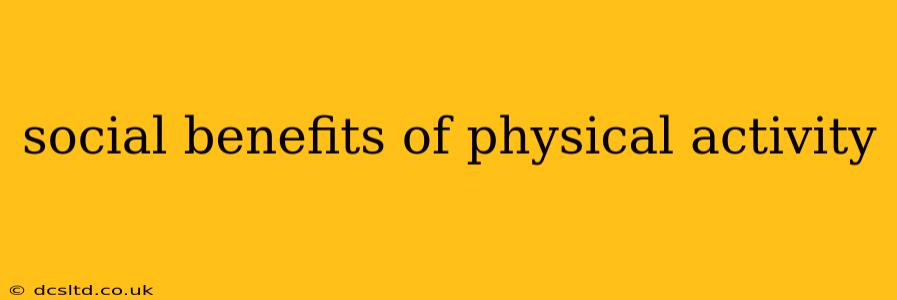Physical activity isn't just about sculpted muscles and a healthy heart; it's a powerful social catalyst with far-reaching benefits for individuals and communities. Engaging in physical activities fosters connections, builds support networks, and enhances overall well-being in ways often overlooked. This article delves into the surprising social advantages of staying active, exploring how exercise can transform not only our physical health but also our social lives.
How Does Physical Activity Improve Social Interactions?
Physical activity provides numerous opportunities for social interaction, fostering a sense of community and belonging. Participating in team sports, group fitness classes, or even simply joining a walking group creates a shared experience that strengthens bonds and builds camaraderie. The collaborative nature of many activities promotes teamwork, communication, and mutual support, enriching social connections beyond the activity itself. This shared experience helps combat loneliness and isolation, critical factors in maintaining mental and emotional well-being.
What Are the Social Benefits of Exercise for Mental Health?
Beyond the physical benefits, the social aspects of physical activity profoundly impact mental health. Exercise releases endorphins, natural mood boosters, and participating in group activities combats feelings of loneliness and isolation, common contributors to depression and anxiety. The sense of accomplishment and shared success experienced in team activities or fitness challenges further boosts self-esteem and confidence, leading to improved social interactions and stronger relationships. Feeling more confident in oneself naturally translates to more positive social interactions.
Does Participating in Group Fitness Activities Enhance Social Connections?
Absolutely! Group fitness classes, team sports, and even informal activities like jogging with a friend provide structured opportunities for social interaction. Shared goals and challenges in group settings foster a sense of unity and camaraderie. The supportive environment created encourages participants to push their limits, celebrate successes together, and offer encouragement during setbacks. This shared experience transcends the physical activity itself, building strong bonds and social support networks. Think of the camaraderie developed amongst runners training for a marathon, or the supportive atmosphere of a Zumba class.
Can Physical Activity Help Combat Loneliness and Social Isolation?
Yes, physical activity is a highly effective tool in combating loneliness and social isolation. Engaging in activities that involve social interaction provides opportunities to connect with others, build relationships, and reduce feelings of isolation. For individuals who might struggle with social anxiety, group activities can offer a less intimidating way to connect with others. The shared focus on the activity itself can ease initial anxieties, allowing for gradual and comfortable social interaction. Joining a local sports club, volunteering for a community event that involves physical activity, or simply walking in a park and striking up conversations are all effective strategies.
How Can I Use Physical Activity to Build Stronger Social Connections?
Building stronger social connections through physical activity is relatively simple. Consider these options:
- Join a sports team or club: Team sports provide a natural environment for socialization, building teamwork and friendship.
- Participate in group fitness classes: Classes like yoga, Zumba, or spin offer a structured setting to meet new people with shared interests.
- Take up a walking or running group: Joining a group provides built-in social interaction and motivation.
- Volunteer for physically active events: Activities like park clean-ups or charity runs combine social good with physical activity.
- Organize informal activities: Invite friends or family for a hike, bike ride, or game of frisbee.
The social benefits of physical activity extend far beyond the gym or sports field. By actively seeking out opportunities for social engagement alongside physical activity, we can enhance our physical and mental well-being while simultaneously strengthening our social connections and building a richer, more fulfilling life.
